

Princess Tutu. Princess Tutu (プリンセスチュチュ, Purinsesu Chuchu?)
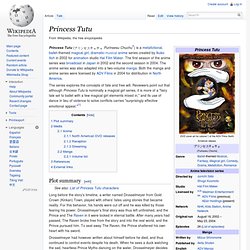
Is a metafictional, ballet-themed magical girl, dramatic-musical anime series created by Ikuko Itoh in 2002 for animation studio Hal Film Maker. The first season of the anime series was broadcast in Japan in 2002 and the second season in 2004. The anime series was also adapted into a two-volume manga. Both the manga and anime series were licensed by ADV Films in 2004 for distribution in North America. The series explores the concepts of fate and free will. Plot summary[edit] Long before the story's timeline, a writer named Drosselmeyer from Gold Crown (Kinkan) Town, played with others' fates using stories that became reality. Drosselmeyer had however written about himself before he died, and thus continued to control events despite his death.
Now a gawky pre-teenager, Duck becomes Mytho's classmate and takes ballet classes with him. Fakir and Duck's perseverance gives Mytho and Rue the strength to finally destroy The Raven. Media[edit] The Three Sisters (fairy tale) The Three Sisters is an Italian literary fairy tale written by Giambattista Basile in his 1634 work, the Pentamerone.
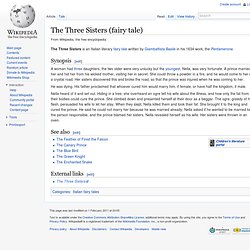
He was dying. His father proclaimed that whoever cured him would marry him, if female, or have half the kingdom, if male. Nella heard of it and set out. Hiding in a tree, she overheard an ogre tell his wife about the illness, and how only the fat from their bodies could cure the prince. She climbed down and presented herself at their door as a beggar. Aarne–Thompson classification system.
The Aarne–Thompson tale type index is a multivolume listing designed to help folklorists identify recurring plot patterns in the narrative structures of traditional folktales, so that folklorists can organize, classify, and analyze the folktales they research.
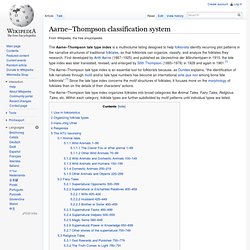
First developed by Antti Aarne (1867–1925) and published as Verzeichnis der Märchentypen in 1910, the tale type index was later translated, revised, and enlarged by Stith Thompson (1885–1976) in 1928 and again in 1961.[1] The Aarne–Thompson tale type index organizes folktales into broad categories like Animal Tales, Fairy Tales, Religious Tales, etc.
Within each category, folktale types are further subdivided by motif patterns until individual types are listed. Use in folkloristics[edit] According to D. Organizing folktale types[edit] The Aarne–Thompson tale type index divides tales into sections with an "AT" number for each entry. Closely related folktales are often grouped within a type. Hans-Jörg Uther[edit] Response[edit] Russian Fairy Tales: Spirits. Koschei. In Slavic folklore, Koschei (Russian: Коще́й, tr.
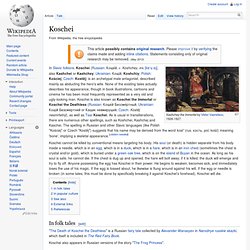
Koshchey, IPA: [kɐˈɕːej], also Kashchei or Kashchey; Ukrainian: Кощій, Koshchiy; Polish: Kościej; Czech: Kostěj) is an archetypal male antagonist, described mainly as abducting the hero's wife. None of the existing tales actually describes his appearance, though in book illustrations, cartoons and cinema he has been most frequently represented as a very old and ugly-looking man. Tsarevitch Ivan, the Fire Bird and the Gray Wolf. It is Aarne-Thompson type 550, the quest for the golden bird/firebird.

Others of this type include "The Golden Bird", "The Greek Princess and the Young Gardener", "The Bird 'Grip'", "How Ian Direach got the Blue Falcon", and "The Nunda, Eater of People".[2] Synopsis[edit] The older brothers set out. They came to a stone that said whoever took one road would know hunger and cold; whoever took the second would live, though his horse would die; and whoever took the third would die, though his horse would live.
They did not know which way to take, and so took up an idle life. Ivan begged to be allowed to go until his father yielded. He met the wolf and admitted to his disobedience. Ivan went back to the wolf, confessed, and was brought to her castle. The wolf said its service was done when they returned to where it had eaten Ivan's horse. The Grey Wolf found Ivan's body and caught two fledgling crows that would have eaten it.
Baba Yaga. Baba Yaga by Ivan Bilibin Click on image for larger version.

Babushka Baba Yaga. Babushka Baba Yaga Activity Ideas Although Baba Yaga of "Babushka Baba Yaga" is known throughout Russia as a "terrible, horrible" creature that eats children, she is really a very sweet woman who exhausts her days watching in admiration of the village babushkas.
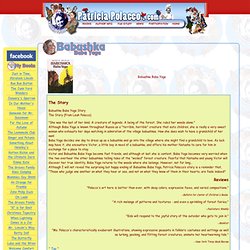
How she does wish to have a grandchild of her own! One day she decides to dress up as a babushka and go into the village in search of a grandchild to love. As luck may have it, she finds Victor, a little boy without a babushka. Although Victor and his mother Natasha grow to love and accept Baba Yaga, she is afraid they will discover her true identity, and consequently, returns to the forest. When Baba Yaga’s identity is revealed at last, the book reminds readers, "Those who judge one another on what they hear or see, and not on what they know of them in their hearts, are fools indeed!
" Discussion Questions: 1. 2. 3. Russian Fairy Tales: Pagan Gods. Swan Maidens. Folktales of Type 400 edited by D.
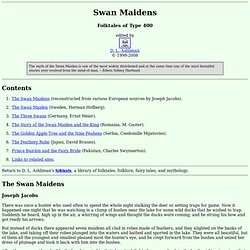
L. Ashliman © 1998-2008 Contents Return to D.